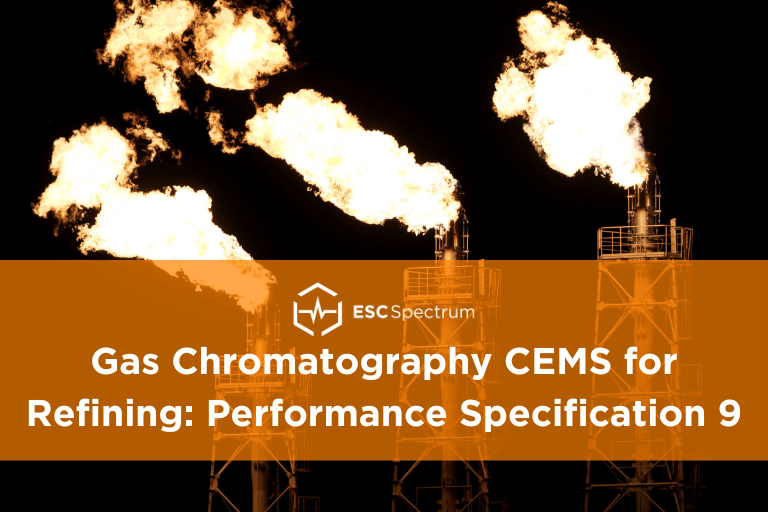What is Performance Specification 9?
Performance Specification 9 (PS-9) establishes the requirements and procedures for Gas Chromatographic Continuous Emission Monitoring Systems (CEMS) in stationary sources. This specification ensures accurate measurement of gaseous organic compound emissions, which is crucial for environmental compliance and monitoring.
Scope and Application
PS-9 is designed for CEMS that use gas chromatography to measure gaseous organic compound emissions. The procedures outlined in PS-9 evaluate the acceptability of CEMS at installation and during periodic checks as specified by regulations and permits. It also includes quality assurance procedures for ongoing calibration, maintenance, and operation.
Key Components and Definitions
- Gas Chromatograph (GC): The part of the system that separates and detects organic analytes and generates an output proportional to the gas concentration. It must be temperature-controlled to maintain stability.
- Column: An analytical column capable of separating the analytes of interest.
- Detector: A system capable of detecting and quantifying all analytes of interest.
- Integrator: Quantifies the area under a sample peak generated by the GC.
- Data Recorder: A device capable of recording all readings within the instrument’s calibration range.
Performance and Calibration
PS-9 specifies calibration precision, calibration error, and performance audit tests to ensure CEMS meet the required standards. Daily calibration and maintenance are essential to maintain the system’s accuracy and reliability.
- Calibration Precision: The error between triplicate injections of each calibration standard.
- Calibration Error: Determined by injecting calibration gases at different concentrations and comparing the instrument’s response to the known values.
- Performance Audit Tests: Conducted during the initial setup and quarterly thereafter to verify the system’s accuracy.
Equipment and Supplies
The sampling system must be heat traced and maintained at a minimum of 120 °C with no cold spots. This includes all system components such as the probe, calibration valve, sample lines, sampling loop, GC oven, and detector block.
Calibration Gases
Calibration gases must be certified by the manufacturer to be accurate within 2% of the value on the label. Three concentrations are required:
- Low-level: 40-60% of measured concentration.
- Mid-level: 90-110% of measured concentration.
- High-level: 140-160% of measured concentration.
Sample Collection and Analysis
The CEMS must be installed in a location where measurements are representative of source emissions. The location should avoid air in-leakages and be positioned appropriately relative to control devices and points of pollutant generation.
Seven-Day Calibration Error Test
At the beginning of each 24-hour period during the seven-day test, a multi-point calibration is conducted. Calibration gases are injected in triplicate at the end of each period to determine calibration error, which must be ≤10%.
Daily and Multi-Point Calibration
Daily calibration involves analyzing the mid-level calibration standard in triplicate. The average instrument response should not vary more than 10% from the certified concentration. Multi-point calibration is required after initial startup, routine maintenance, or repair, and at least once per month.
Looking for a deep dive into flare monitoring? Read Decoding the World of Flare Gas Monitoring.
Specific Modifications for Subpart CC
For continuous determination of Net Heating Value (NHV) for flares in 40 CFR part 63 subpart CC, several modifications to PS-9 requirements are allowed:
- Daily Calibration Check: A single daily mid-level calibration check replaces the triplicate analysis.
- Quarterly Multi-Point Calibrations: Conducted instead of monthly calibrations.
- Sampling Line Temperature: Minimum temperature reduced from 120°C to 60°C.
Test Gases and Calibration
Test gases must either contain specific compounds listed in 40 CFR 63.671(e)(2)(i) or hydrogen and C1 through C5 normal hydrocarbons. Response factors for the nearest normal hydrocarbon are used to quantify unknown components.
Performance Audits and QC Checks
Performance audits must be conducted quarterly and include mid-level calibration gas injected three times through the sample transport system. Both multi-point calibrations and performance audits are required as they serve different purposes.
Recordkeeping and Compliance
Facilities must record and maintain individual component concentrations for a minimum of two years. This ensures transparency and allows for the recalculation of NHV during compliance reviews.
For frequently asked questions for these PS-9 in 40 CFR Part 63 Subpart CC, visit here. For a deeper dive into 40 CFR Part 63 Subpart CC, read our blog post.
How ESC Spectrum Can Help
At ESC Spectrum, we specialize in providing comprehensive solutions for Continuous Emission Monitoring Systems (CEMS). Our Gas Chromatography-based CEMS offerings are designed to meet stringent regulatory requirements and ensure optimal performance.
Our industry-leading data acquisition system software, StackVision, and Prism, are used by 3,100+ facilities across the U.S. for accurate and reliable air emissions monitoring and reporting to meet federal, state, and local requirements.
StackVision works seamlessly with the 8864 Data Controller to collect, monitor, QA, and report on emissions data from CEM systems accurately and reliably. Learn more about why our 8864 Data Controller is the best way to mitigate risks at your refinery in our blog post.
For a complete resource on emissions monitoring, explore our Comprehensive Emissions Monitoring Guide for Refining and Petrochemical Facilities, covering everything from best practices to regulatory compliance.

Reagan Sokolosky - Marketing Specialist III
Reagan is a Strategic Communications graduate from Oklahoma State University who joined ESC Spectrum in April of 2020. She dove headfirst into the air emissions compliance industry with no prior experience. She has been writing and researching about air emissions for 4 years to educate our customers. Within four years, Reagan advanced to Marketing Specialist III, showcasing expertise in ESC Spectrum’s learning offerings, email marketing, video editing, product and software releases, and company rebranding.
Contact Reagan at rsokolosky@escspectrum.com for questions or comments.


